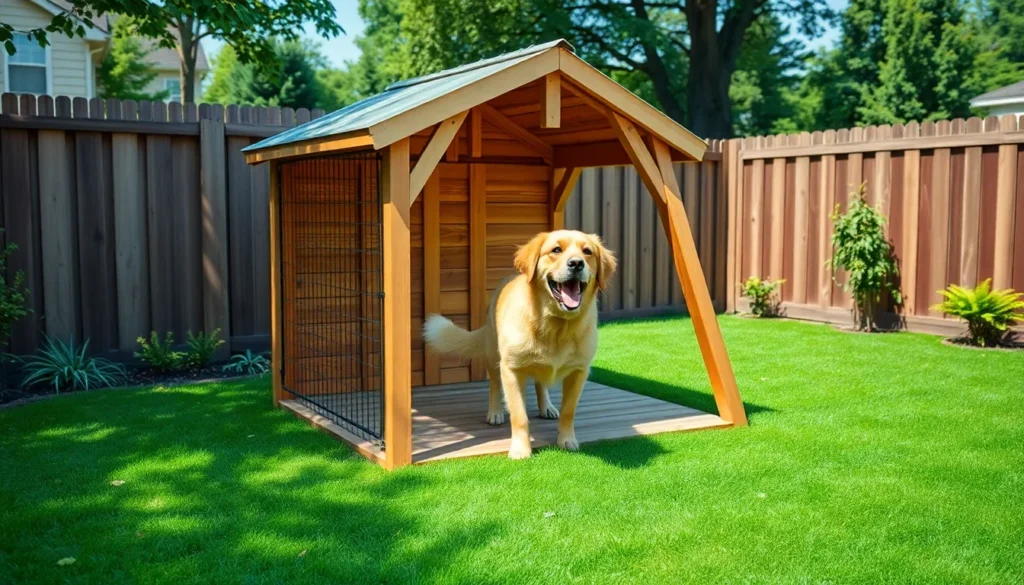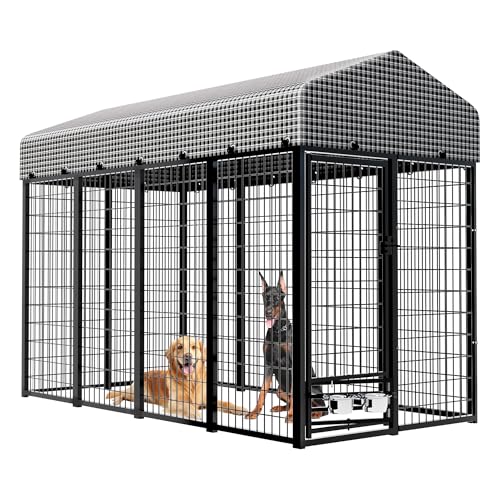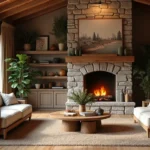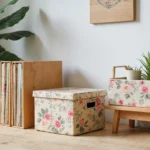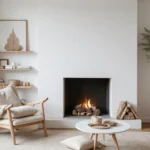Creating the perfect outdoor dog kennel transforms your backyard into a safe haven where your furry friend can enjoy fresh air while staying secure. We’ve all faced the challenge of balancing our dog’s need for outdoor time with concerns about safety and containment. The right kennel design doesn’t just provide security – it becomes an extension of your home that keeps your pet happy and comfortable.
Whether you’re dealing with a small yard or have acres to work with we’ll show you innovative outdoor kennel ideas that maximize space and functionality. From budget-friendly DIY answers to premium custom builds there’s an outdoor kennel design that fits every lifestyle and budget.
The best outdoor kennels combine durability weather resistance and thoughtful features that make maintenance a breeze. We’re here to guide you through the most effective designs materials and layouts that’ll keep your dog safe while giving you peace of mind.
Traditional Wooden Dog Kennel Designs
Traditional wooden dog kennels remain the most popular choice among pet owners due to their natural durability and timeless aesthetic appeal. These designs blend seamlessly with outdoor landscapes while providing the structural integrity needed for long-term pet safety.
Classic A-Frame Structures
A-frame wooden kennels offer excellent weather protection through their triangular roof design that naturally sheds rain and snow. We’ve found these structures particularly effective for medium to large dogs who need spacious overhead clearance. The slanted walls provide superior drainage while maximizing interior space without requiring complex construction techniques.
Building an A-frame kennel typically requires basic carpentry skills and standard lumber like pressure-treated 2x4s for the frame and exterior-grade plywood for the walls. Weather-resistant cedar or pine boards create attractive siding that withstands outdoor conditions for years. Most A-frame designs feature removable roof panels that allow easy interior cleaning and maintenance access.
Raised Platform Kennels
Raised platform designs elevate your dog’s living space above ground level to prevent moisture damage and improve air circulation. These kennels work exceptionally well in areas with heavy rainfall or snow since the elevated floor stays dry and comfortable year-round. We recommend platform heights between 6 to 12 inches depending on your local climate conditions.
Constructing a raised platform requires additional support beams and foundation posts made from rot-resistant materials like cedar or composite lumber. The elevated design also deters pests and small animals from accessing the kennel space. Stairs or ramps provide easy access for dogs while maintaining the structural benefits of elevation.
Log Cabin Style Enclosures
Log cabin kennels create rustic outdoor spaces that complement country homes and wooded properties perfectly. These substantial structures use interlocking logs or log-style siding to create thick walls that provide excellent insulation against temperature extremes. We’ve observed that dogs feel more secure in these enclosed environments due to the solid construction and natural materials.
Traditional log cabin kennels require more advanced building skills but offer superior longevity compared to standard wooden designs. Half-log siding over conventional framing provides the authentic appearance while reducing construction complexity and material costs. Chinking between logs ensures weatherproofing while maintaining the classic cabin aesthetic that many homeowners prefer.
Modern Metal and Wire Dog Kennels

Contemporary metal and wire kennels represent the evolution of outdoor pet housing, combining sleek aesthetics with superior functionality. These designs match modern home styles while delivering the durability and visibility that today’s pet owners demand.
Galvanized Steel Chain Link Runs
Galvanized steel chain link runs offer unmatched rust resistance and strength for secure dog containment. We recommend these systems because they effectively contain dogs of all sizes while maintaining excellent visibility for monitoring your pet’s activities.
The galvanized coating process creates a protective barrier that extends the kennel’s lifespan significantly compared to standard steel options. Steel chain link runs work exceptionally well when paired with gravel or concrete flooring, which minimizes maintenance requirements and eliminates muddy conditions during wet weather.
Installation becomes straightforward with proper planning, and the open design allows excellent airflow throughout the enclosure. Most galvanized systems can accommodate multiple dogs comfortably while providing the security needed for even the most determined escape artists.
Powder-Coated Aluminum Frames
Powder coated aluminum frames deliver lightweight construction without sacrificing weather resistance or durability. We prefer aluminum frames because they resist corrosion naturally while offering customization options through various color choices that complement your backyard design.
The powder coating process adds an extra protective layer that prevents wear and maintains the frame’s appearance over time. Aluminum’s lightweight nature makes installation easier compared to heavier steel alternatives, yet these frames maintain structural integrity in harsh weather conditions.
Color customization allows you to blend the kennel seamlessly with your existing outdoor decor, creating a cohesive industry design. These frames typically require minimal maintenance beyond occasional cleaning, making them ideal for busy pet owners who want durability without constant upkeep.
Modular Panel Systems
Modular panel systems provide ultimate flexibility by allowing easy expansion or reconfiguration as your needs change. We choose modular designs because they adapt to growing families, multiple pets, or changing yard layouts without requiring complete reconstruction.
Panels lock together securely using specialized connectors that maintain structural stability while enabling quick adjustments. These systems often include integrated features like built in dog doors, shading panels, and gate options that enhance functionality without requiring separate installations.
Expansion capabilities make modular systems cost effective over time, as you can start with a basic configuration and add panels as needed. Installation typically requires basic tools and can be completed by most homeowners, eliminating the need for professional contractors in many cases.
DIY Budget-Friendly Outdoor Kennel Ideas
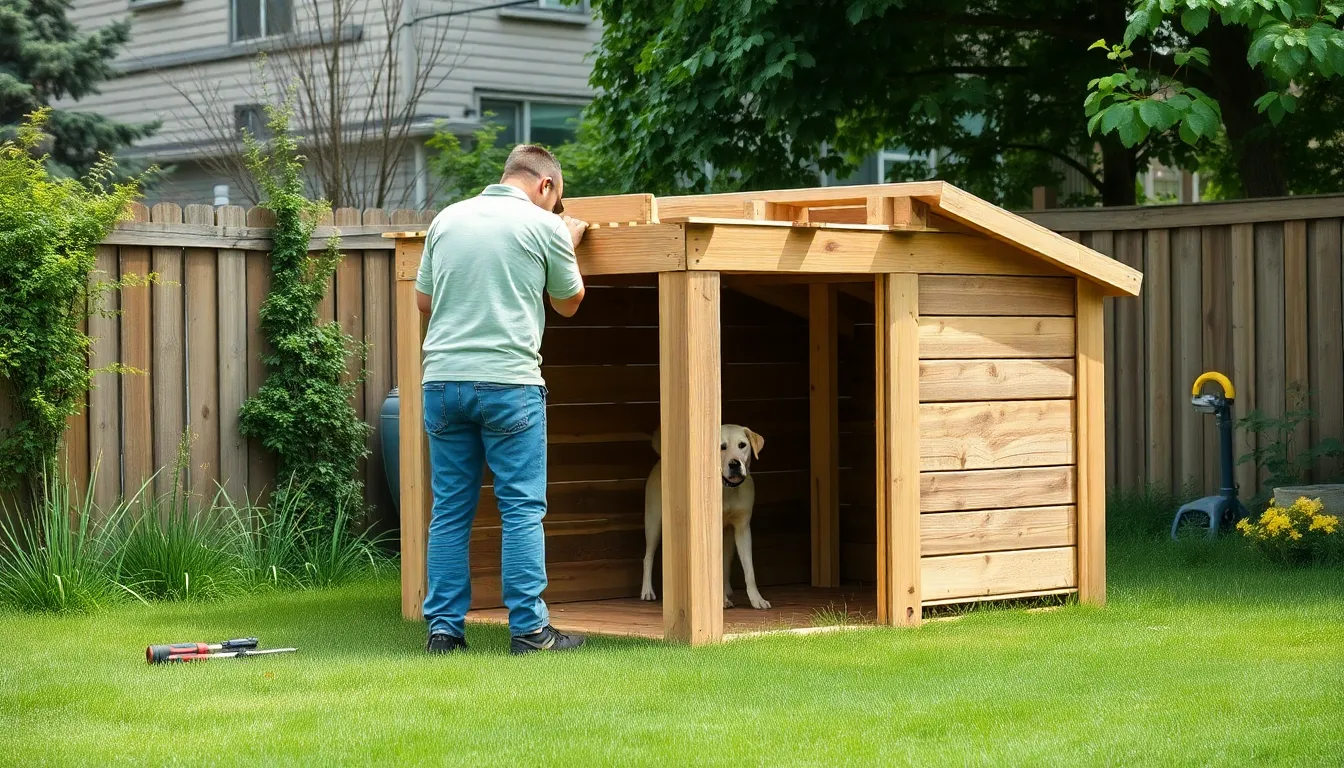
Creating your own outdoor dog kennel doesn’t have to expensive. We’ve discovered several cost-effective approaches that deliver professional results while keeping expenses manageable.
Pallet Wood Construction Projects
Pallet wood offers one of the most economical answers for building sturdy outdoor dog kennels. We can construct durable enclosures using pallet palings and stringers that provide excellent structural integrity.
Building starts with cutting palings to create wall sections and marking precise door openings for easy access. We’ll need to focus on creating a removable roof frame that allows for maintenance and cleaning. This construction method adapts perfectly to different dog sizes by adjusting dimensions accordingly.
The versatility of pallet materials means we can customize each kennel to match exact yard layouts and pet requirements. Sturdy joints between palings create secure walls that withstand weather conditions while maintaining adequate ventilation through natural gaps.
PVC Pipe Framework Designs
PVC pipe frameworks create lightweight yet weather-resistant structures that excel in outdoor environments. We can assemble these frames quickly using standard fittings and cover them with tarps or shade cloth for complete protection.
Weather resistance becomes a major advantage since PVC materials don’t rust or deteriorate like metal alternatives. Easy assembly means we can disassemble and relocate these kennels when needed, making them perfect for temporary or seasonal setups.
Moving these structures requires minimal effort due to their lightweight construction. Covering options include UV-resistant fabrics that protect dogs from sun exposure while allowing proper airflow throughout the enclosure.
Repurposed Shed Conversions
Converting existing sheds into dog kennels provides excellent value and maximum space utilization. We can transform these structures by adding insulation, improving ventilation, and installing secure entry doors for safety.
Insulation becomes crucial for year-round comfort, especially in climates with temperature extremes. Adding mesh windows or ventilation systems ensures proper airflow while maintaining security. Installing dog doors gives pets freedom to move between indoor and outdoor areas.
Space advantages make shed conversions ideal for larger dogs or multiple pets. Features like built-in storage areas, elevated sleeping platforms, and weather-protected feeding stations enhance functionality while maximizing the existing structure’s potential.
Weatherproof and Climate-Controlled Kennels

Advanced outdoor kennels now feature sophisticated climate control systems that maintain comfortable temperatures throughout the year. Modern engineering combines durability with smart temperature regulation to create environments that protect dogs from extreme weather conditions.
Insulated Dog House Combinations
Insulated kennel designs use double-walled construction with foam layers that reduce heat loss during winter months and maintain cool interiors in summer. Cedar wood exteriors paired with glass board linings create easy-to-clean surfaces while providing superior chewing resistance and weather protection. We’ve found that these combinations offer year-round comfort through strategic material layering.
Temperature regulation becomes more effective when insulation materials work together with breathable yet protective outer shells. Glass board interior panels resist moisture damage while foam insulation maintains consistent internal temperatures. These dual-layer systems create comfortable microclimates that adapt to seasonal temperature changes.
Structural integrity improves when insulated panels integrate seamlessly with galvanized steel frames that resist rust and decay. Double wall systems trap air between layers, creating natural thermal barriers that reduce energy loss. Manufacturers now offer insulated dog houses with R-values comparable to residential construction standards.
Heated and Cooled Enclosure Options
Heated enclosures incorporate radiant floor heating systems that distribute warmth evenly across kennel floors without creating hot spots. Thermostat-controlled environments maintain precise temperatures between 65-75°F regardless of external weather conditions. We recommend systems that include automatic temperature monitoring for consistent comfort.
Cooling answers feature ventilation fans strategically placed to create cross-breezes that remove hot air while drawing in fresh airflow. Insulated dog doors minimize temperature fluctuations by creating sealed barriers when dogs aren’t actively moving between spaces. Some high-end models integrate both heating and cooling systems for comprehensive climate control.
Power requirements for these systems typically range from 100-300 watts for heating elements and 50-150 watts for cooling fans. Energy-efficient designs often include timers and sensors that activate climate control only when needed. Installation costs vary from $200-800 depending on system complexity and kennel size.
Storm-Resistant Shelter Designs
Storm-resistant kennels feature heavy-duty anchoring systems tested to withstand wind speeds up to 100 mph and snow loads exceeding 30 inches. Powder-coated steel frames with fully welded panels create structures that maintain integrity during severe weather events. We’ve observed that these designs prevent kennel collapse while keeping dogs secure during storms.
Anchoring mechanisms include concrete footings and ground stakes that distribute wind loads across multiple contact points. Welded panel construction eliminates weak joints that might separate under pressure from high winds or falling debris. Gates feature reinforced hinges and multiple locking points to prevent accidental opening during storms.
Testing standards for storm-resistant kennels often exceed residential building codes, with some models certified for hurricane-force winds. Galvanized steel components resist corrosion from salt air and moisture that accompany severe weather systems. Manufacturers typically provide installation guides that specify proper anchoring techniques for different soil types and regional weather patterns.
| Feature | Specifications | Weather Resistance |
|---|---|---|
| Wind resistance | Up to 100 mph | Hurricane-force storms |
| Snow load capacity | 30+ inches | Heavy winter conditions |
| Frame material | Powder-coated steel | Rust and corrosion resistant |
| Panel construction | Fully welded | Eliminates weak joints |
| Anchoring system | Concrete footings | Multiple ground contact points |
Large Breed and Multi-Dog Kennel Solutions

When housing multiple dogs or accommodating larger breeds, we need specialized kennel systems that prioritize space, organization, and practical management features.
Spacious Run Configurations
Run dimensions of 8×16 feet provide optimal exercise space for large breeds and multi-dog setups. We recommend these generous configurations because they allow dogs to move freely while maintaining secure boundaries. Premium kennels feature UV-resistant roofing systems that protect against sun damage and weather exposure. Metal framing constructed from durable materials ensures structural integrity even with active large breeds.
Custom-built commercial kennels offer superior durability compared to standard residential options. These professional-grade systems withstand the demands of multiple dogs and heavy daily use. We’ve found that luxury kennel configurations provide the reliability needed for serious breeders and multi-dog households.
Separate Sleeping and Play Areas
Insulated living boxes create comfortable sleeping quarters separate from active play zones. This zoning approach reduces stress levels and maintains cleaner resting areas for your dogs. We design these spaces with lined interiors that provide temperature regulation throughout different seasons.
Adjacent covered runs serve as dedicated exercise areas while keeping sleeping spaces undisturbed. Open run sections allow for natural play behaviors and social interaction between dogs. Covered portions provide shade and weather protection during outdoor activities.
Zone separation enhances overall animal well-being by giving dogs control over their environment. We’ve observed that dogs naturally prefer having distinct areas for rest and activity. This design approach mimics natural denning behaviors and promotes better sleep patterns.
Multiple Entry and Exit Points
Multiple gate systems improve management efficiency for caregivers handling several dogs simultaneously. We install strategic access points that allow entry without disturbing resting animals. These configurations enable easy separation or combination of dogs into different kennel sections as needed.
Chew-proof doors with protective edging maintain long-term security in multi-dog environments. Durable construction materials resist damage from persistent chewing or scratching behaviors. We recommend reinforced hinges and locking mechanisms that withstand daily use from multiple animals.
Strategic door placement facilitates cleaning and maintenance routines while ensuring continuous containment. Access points positioned at different kennel sections allow for thorough cleaning without relocating all dogs. This design feature proves especially valuable during feeding times and health check procedures.
| Feature | Benefit | Price Range |
|---|---|---|
| 8×16 foot runs | Optimal exercise space | $3,000-$5,000 |
| Insulated living boxes | Temperature control | $2,000-$3,500 |
| Multiple gate systems | Easy management | $500-$1,200 |
| Premium complete systems | Full functionality | $10,000-$15,000+ |
Creative and Aesthetic Outdoor Kennel Designs

Moving beyond basic functionality, we’re exploring innovative design approaches that transform ordinary kennels into stunning backyard features. These creative answers blend practical dog housing with aesthetic appeal to enhance your outdoor space.
Garden-Integrated Kennel Concepts
Garden integration maximizes both utility and visual harmony by placing kennels strategically among flower beds, grassy areas, and garden paths. We recommend positioning these structures where dogs can enjoy natural surroundings while remaining safely contained within designated spaces.
Raised platform designs reduce mud accumulation and simplify cleaning routines by elevating the kennel above ground level. These elevated structures work particularly well with soft ground covers like grass or gravel underneath, creating comfortable surfaces for your pet’s paws.
Combined kennel and garden shed installations create cohesive backyard layouts while providing dogs with comfortable, shaded relaxation areas. This dual purpose approach maximizes space efficiency and creates a more organized outdoor environment that serves both gardening and pet care needs.
Decorative Fencing and Gate Options
Fencing selection significantly impacts both safety levels and overall aesthetic appeal of your outdoor kennel design. We’ve found that horizontal slat gates, wire mesh panels, and curved metal gates offer excellent security while maintaining stylish appearances that complement existing landscaping.
Tall wire fence installations prevent escape attempts while wood or composite materials add natural warmth that blends seamlessly with outdoor decor. These material choices provide durability without sacrificing the visual appeal that homeowners desire in their backyard spaces.
Unique gate designs featuring arched or lattice patterns enhance curb appeal while maintaining functional access to the kennel area. These decorative elements can complement existing backyard landscaping themes and create focal points that draw positive attention to your outdoor pet facilities.
Landscaped Surroundings and Pathways
Strategic landscaping materials like gravel, mulch, and pavers ensure easy maintenance while creating tidy appearances around kennel structures. We recommend selecting materials that drain well and resist tracking into your home when dogs move between indoor and outdoor spaces.
Pathway design leading to kennels can incorporate plants, stones, or decorative edging for polished, professional looks. These guided walkways create clear access routes while adding visual interest that integrates the kennel naturally into your overall yard design.
Natural barrier creation using shrubs, small trees, and flower beds provides shade, privacy, and pleasant environments for pets while seamlessly integrating kennels into existing landscapes. These living elements soften hard structural lines and create more inviting spaces that both dogs and homeowners can enjoy.
Safety Features and Security Considerations
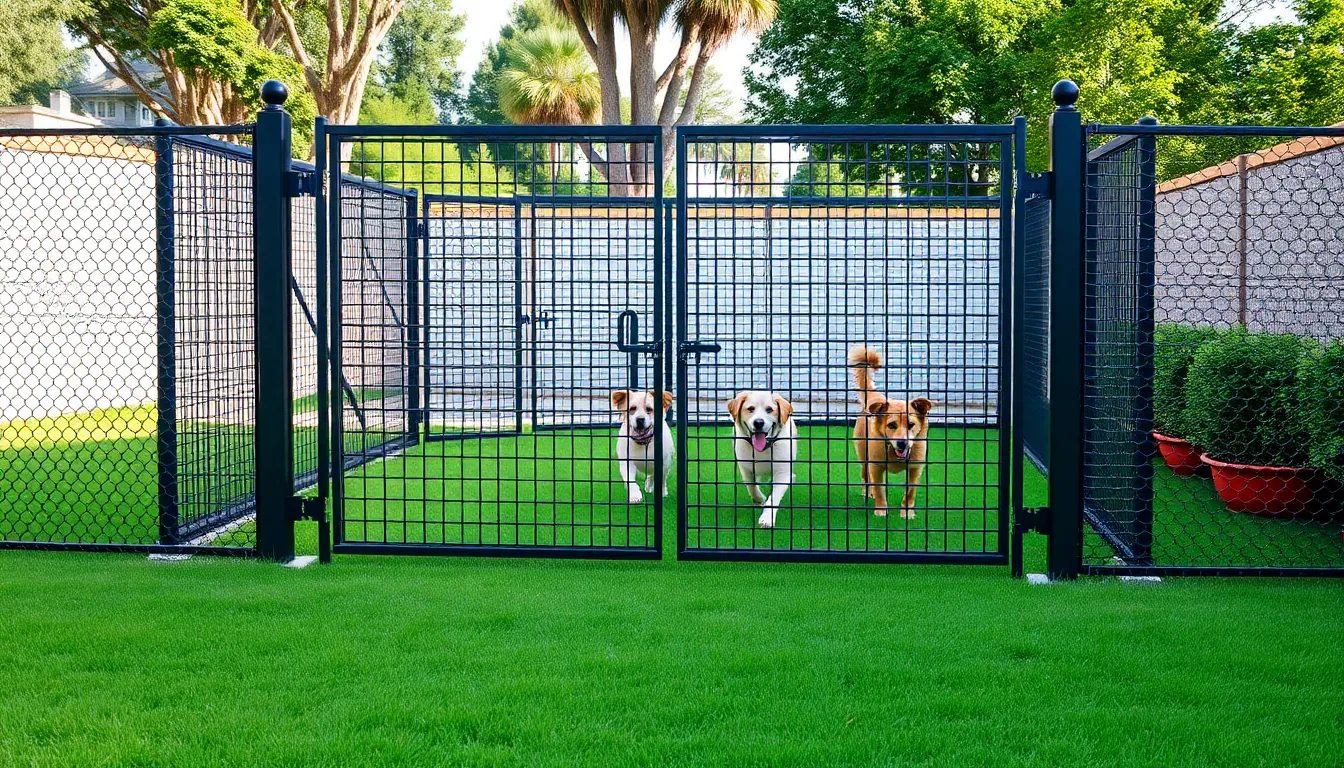
Creating a secure outdoor kennel requires careful attention to exact safety elements that protect our dogs while preventing unauthorized access. We’ll explore the most critical security features that make outdoor kennels both safe and escape proof.
Double-Gate Entry Systems
Implementing a double gate entry system creates an additional layer of security that prevents both escape attempts and unauthorized access to your kennel area. We recommend installing these systems with a buffer zone between the two gates, allowing you to enter the first gate and secure it before opening the second one. This approach is particularly valuable when dealing with multiple dogs or highly energetic breeds that might attempt to bolt through open doors.
Benefits of double gate systems include enhanced safety during feeding times, easier management of multiple pets, and reduced stress for both dogs and owners. The buffer zone also serves as a staging area where you can store supplies or prepare food without risk of escape.
Escape-Proof Latching Mechanisms
Heavy duty latches that resist pawing or pushing represent the foundation of any secure outdoor kennel system. We’ve found that spring loaded mechanisms and thumb operated latches work best because dogs cannot manipulate them with their paws or noses. Standard gate latches often fail when intelligent dogs learn to lift or slide them open.
Key features to look for in escape proof latches include corrosion resistant materials, smooth operation for human use, and mechanisms that require opposing thumb pressure or complex movements. Magnetic latches also provide excellent security since dogs cannot understand the magnetic release mechanism.
Regular maintenance of latching systems ensures continued reliability and prevents wear that could lead to escape opportunities. We recommend checking all latches monthly and immediately replacing any that show signs of loosening or damage.
Ground Anchoring and Foundation Options
Secure anchoring prevents kennel shifting and ensures structural stability during weather events or when dogs play vigorously against the walls. We recommend concrete foundations as the gold standard for permanent installations, as they provide unmatched stability and longevity.
Heavy duty ground anchors offer excellent alternatives for kennels that may need relocation or for renters who cannot pour concrete. These systems typically use spiral anchors or expansion bolts that penetrate deep into the soil for maximum holding power.
| Foundation Type | Stability Rating | Installation Time | Cost Range |
|---|---|---|---|
| Concrete Slab | Excellent | 2-3 days | $8-12 per sq ft |
| Heavy Duty Anchors | Very Good | 2-4 hours | $15-25 per anchor |
| Gravel Base | Good | 4-6 hours | $3-5 per sq ft |
Covered floors provide additional security benefits by preventing digging attempts while maintaining cleanliness and reducing maintenance requirements. We’ve observed that dogs housed in kennels with proper flooring show less destructive behavior and remain healthier overall.
Essential Accessories and Add-Ons
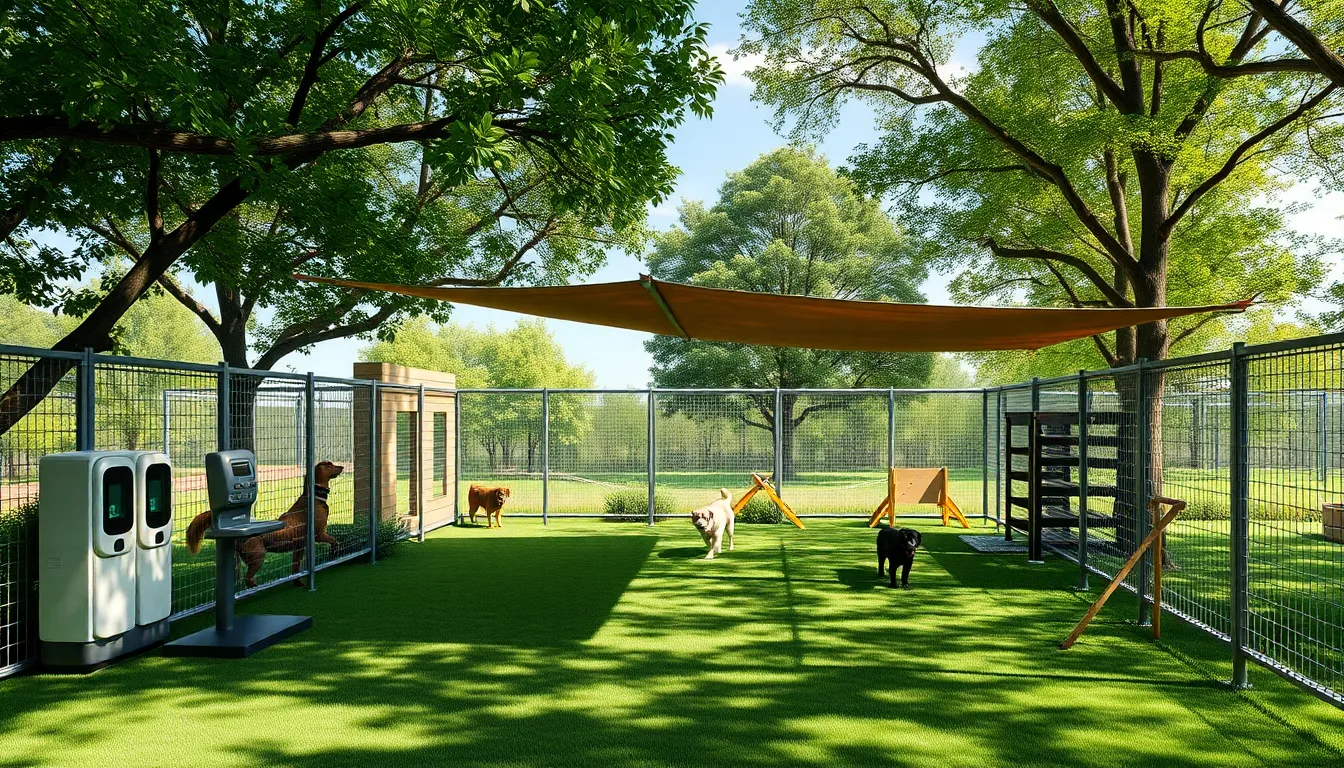
We can transform our basic outdoor kennel into a comprehensive canine retreat by selecting the right accessories and add-ons. Strategic enhancements not only improve our dogs’ comfort but also reduce our daily maintenance workload.
Automatic Water and Food Systems
Automated food and water dispensers eliminate the worry of keeping our pets properly nourished throughout the day. Busy pet owners find these systems invaluable for maintaining consistent feeding schedules and ensuring fresh water access at all times. Integration into existing kennel designs makes installation straightforward while maintaining cleanliness standards that manual feeding often lacks.
We recommend positioning these systems away from high-traffic areas to prevent contamination from dirt and debris. Stainless steel dispensers resist rust and bacterial growth better than plastic alternatives. Gravity-fed water systems work reliably without electricity, while programmable feeders offer portion control for dogs with exact dietary needs.
Shade Structures and Cooling Elements
Shade protection becomes critical for outdoor kennels, especially during summer months when direct sunlight can create dangerous temperature conditions. Awning-style roofs provide adjustable coverage that we can modify based on seasonal sun angles and weather patterns. Gazebo tops with UV-resistant fabric offer comprehensive protection while maintaining proper airflow circulation throughout the enclosure.
Natural shade from strategically planted trees creates long-term cooling answers that improve over time as vegetation matures. We can install fans when electrical connections are available, providing active air circulation that significantly reduces ambient temperatures. Windows increase ventilation effectiveness while allowing us to monitor our pets from inside the house.
Elevated flooring systems keep dogs dry and comfortable by preventing direct ground contact that transfers cold or heat. Air conditioning units may be necessary in humid climates or for temperature-sensitive breeds that struggle with heat regulation.
Exercise Equipment and Enrichment Tools
Physical activity equipment transforms static kennels into captivating play environments that promote our dogs’ mental and physical well-being. Large wood cable reels serve as climbing obstacles that encourage natural jumping and exploration behaviors. Rubber tires create safe, bouncy surfaces for interactive play while withstanding outdoor weather conditions.
Interactive play structures challenge our pets mentally, reducing boredom-related behaviors like excessive barking or destructive chewing. We should select chew toys specifically designed for outdoor use, as these resist UV degradation and maintain structural integrity longer than indoor alternatives. Agility equipment such as tunnels, ramps, and hurdles provides structured exercise opportunities that keep active breeds properly stimulated.
Puzzle feeders and treat-dispensing toys extend meal times while encouraging problem-solving skills that keep intelligent breeds engaged throughout the day.
Conclusion
Creating the perfect outdoor dog kennel doesn’t have to be overwhelming when you have the right guidance and ideas. We’ve explored everything from traditional wooden designs to modern metal frameworks and budget-friendly DIY answers that can transform any backyard into a safe haven for your furry friends.
The key is choosing materials and features that match your exact needs whether that’s climate control for extreme weather or spacious configurations for multiple dogs. Remember that investing in quality construction and safety features upfront saves money and worry in the long run.
Your dog’s outdoor kennel should be more than just containment—it’s their personal retreat where they can safely enjoy fresh air exercise and mental stimulation. With the right design approach your kennel will become a beautiful functional addition to your outdoor space that both you and your pet will love for years to come.
Frequently Asked Questions
What size outdoor dog kennel do I need for my dog?
For medium to large dogs, an 8×16 feet run configuration provides optimal exercise space. The kennel should allow your dog to stand, turn around, and lie down comfortably. Consider your dog’s adult size, activity level, and whether you plan to house multiple dogs when determining dimensions.
What materials are best for outdoor dog kennels?
Galvanized steel chain link offers excellent rust resistance and strength, while powder-coated aluminum frames provide lightweight, corrosion-resistant construction. For traditional options, treated wood offers natural durability and aesthetic appeal. Choose materials based on your climate, budget, and maintenance preferences.
How much does an outdoor dog kennel cost?
Outdoor dog kennels range from budget-friendly DIY options using pallet wood (under $200) to premium multi-dog systems with climate control ($2,000-$5,000+). Basic metal kennels typically cost $300-$800, while custom wooden structures range from $500-$1,500 depending on size and features.
Do outdoor dog kennels need weather protection?
Yes, outdoor kennels require adequate weather protection including covered roofing, proper drainage, and windbreaks. Insulated designs with double-walled construction help regulate temperature year-round. Consider adding heated and cooled systems for extreme climates to ensure your dog’s comfort and safety.
Can I build a DIY dog kennel?
Absolutely! DIY options include pallet wood construction, PVC pipe frameworks, and shed conversions. These budget-friendly approaches can deliver professional results when properly planned. Ensure proper ventilation, secure latching mechanisms, and weather-resistant materials regardless of your chosen DIY method.
What safety features should outdoor kennels have?
Essential safety features include double-gate entry systems, escape-proof heavy-duty latches, and proper ground anchoring with concrete foundations. Ensure adequate spacing between fence panels, smooth surfaces without sharp edges, and secure overhead coverage to prevent jumping or climbing escapes.
How do I maintain an outdoor dog kennel?
Regular maintenance includes cleaning water and food systems, checking for loose panels or hardware, and treating wood surfaces annually. Choose gravel or concrete flooring for easy cleaning, inspect latches and hinges monthly, and ensure proper drainage to prevent moisture buildup and odors.
What accessories enhance outdoor dog kennels?
Popular accessories include automatic food and water systems, shade structures, exercise equipment like climbing obstacles, and interactive play structures. These additions promote physical and mental well-being while reducing maintenance workload. Consider your dog’s specific needs and activity preferences when selecting accessories.

